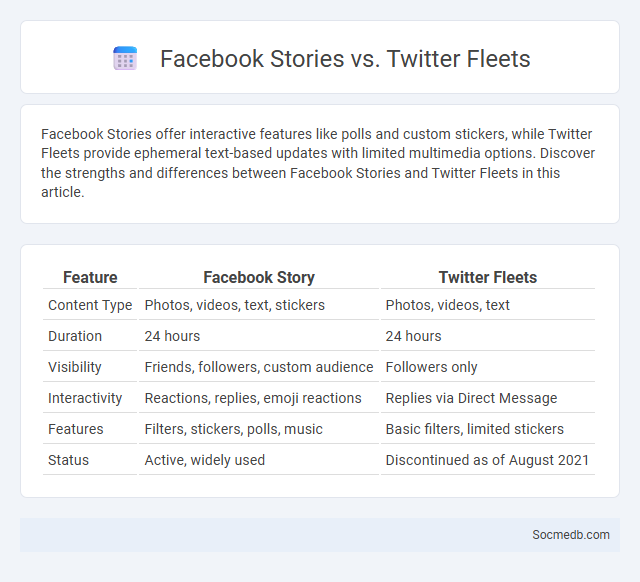
Photo illustration: Facebook Story vs Twitter Fleets
Facebook Stories offer interactive features like polls and custom stickers, while Twitter Fleets provide ephemeral text-based updates with limited multimedia options. Discover the strengths and differences between Facebook Stories and Twitter Fleets in this article.
Table of Comparison
| Feature | Facebook Story | Twitter Fleets |
|---|---|---|
| Content Type | Photos, videos, text, stickers | Photos, videos, text |
| Duration | 24 hours | 24 hours |
| Visibility | Friends, followers, custom audience | Followers only |
| Interactivity | Reactions, replies, emoji reactions | Replies via Direct Message |
| Features | Filters, stickers, polls, music | Basic filters, limited stickers |
| Status | Active, widely used | Discontinued as of August 2021 |
Introduction to Social Media Stories
Social media stories are short, engaging multimedia posts that disappear after 24 hours, creating a sense of urgency and exclusivity. Platforms like Instagram, Facebook, and Snapchat have popularized stories, enabling users to share real-time updates, behind-the-scenes content, and interactive elements such as polls and quizzes. These stories boost user engagement by fostering authentic, ephemeral communication that enhances brand visibility and personal connections.
Overview of Facebook Story
Facebook Story lets you share photos and videos that disappear after 24 hours, encouraging real-time interaction with your friends and followers. Your Story appears at the top of the Facebook app, making it easy for people to view and respond quickly, enhancing engagement through reactions and direct messages. Using Facebook Story boosts your visibility and helps you connect authentically with your audience by sharing spontaneous, short-lived content.
Twitter Fleets: Features and Functionality
Twitter Fleets offer a unique way to share temporary content that disappears after 24 hours, providing a more casual and ephemeral communication style. You can easily post text, photos, videos, and GIFs in Fleets, making them versatile for sharing updates, thoughts, or promotions without cluttering your main timeline. This feature encourages more frequent interaction and engagement by fostering authentic, real-time conversations with your followers.
Comparing Facebook Story, Twitter Fleets, and Instagram Story
Facebook Story, Twitter Fleets, and Instagram Story all offer ephemeral content with varying features tailored to user interaction and visibility. Instagram Story leads with extensive creative tools like filters, stickers, and polls, enhancing engagement, while Facebook Story integrates seamless sharing with your existing Facebook friends and adds location-based features. Twitter Fleets, though recently discontinued, emphasized fleeting content designed for quick, casual updates without the permanence of tweets, primarily targeting real-time conversational usage. Your choice depends on whether you prioritize creative control, audience reach, or spontaneous communication.
User Engagement Across Platforms
User engagement across social media platforms varies significantly due to differences in interface design, content types, and audience demographics. Platforms like Instagram and TikTok drive higher engagement rates through visual content and interactive features such as stories, reels, and live videos. Data from Sprout Social indicates that posts with multimedia content receive 650% higher engagement compared to text-only posts, emphasizing the importance of platform-specific content strategies.
Content Creation Tools and Editing Options
Content creation tools on social media platforms feature advanced editing options such as filters, cropping, text overlays, and enhanced color correction, enabling users to produce high-quality visuals that boost engagement. AI-powered features like auto-enhance, background removal, and video trimming streamline the editing process, making content creation accessible even for beginners. Integration with scheduling and analytics tools further optimizes the content planning and performance tracking, resulting in more effective social media campaigns.
Privacy and Audience Controls
Social media platforms implement privacy and audience controls to protect user data and manage content visibility, including features like customizable friend lists, blocked users, and content-sharing settings. These controls empower users to restrict who can view posts, personal information, and location data, reducing risks of unauthorized access and improving online safety. Enhanced privacy settings and audience segmentation tools contribute to a more secure and personalized social media experience.
Brand Marketing Opportunities
Social media platforms offer unparalleled brand marketing opportunities by enabling precise audience targeting and real-time engagement. With tools like Instagram Shopping, Facebook Ads, and TikTok influencer collaborations, businesses can drive brand awareness, boost conversions, and foster community loyalty. Leveraging data analytics on these platforms allows brands to refine campaigns and maximize return on investment effectively.
User Adoption and Trends
Social media platforms have witnessed exponential user adoption, with over 4.7 billion active users globally as of 2024, driven by mobile accessibility and diversified content formats such as short videos and live streams. Emerging trends emphasize the rise of AI-powered personalization, ephemeral content, and increased integration of e-commerce features, transforming user engagement and digital marketing strategies. Growth in niche communities and augmented reality (AR) experiences further shape user behavior, promoting deeper interaction and content relevance across platforms like TikTok, Instagram, and emerging decentralized networks.
Future of Stories in Social Media
The future of stories in social media revolves around immersive, interactive content that enhances user engagement through augmented reality (AR) and artificial intelligence (AI) technologies. Platforms are evolving to offer personalized, short-lived stories that prioritize authentic, real-time experiences while integrating seamless e-commerce opportunities. Your brand can leverage these innovations to create dynamic narratives that resonate deeply with target audiences and drive meaningful connections.
 socmedb.com
socmedb.com